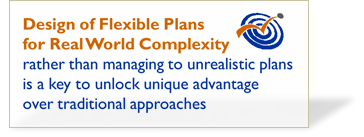Frequently Asked Questions
|
How does TeamPort relate to Project Management Tools?
TeamPort complements existing tools, yet displaces them on the strategic, front-end of projects. How? Traditional project methods and tools were crafted for an earlier industrial era. In the past, a project leader could trust experience and know-how alone, assuming product, process, and organization would be relatively stable -- consistent with past projects. Traditional tools emphasize detail tasks, individual resource schedules, and centralized, top down control. Very often, plans generated using traditional techniques are elaborate and detailed, yet infeasible and burdensome. TeamPort plays a very different role, used early-on and at a high-level to determine architecturally the best overall design for a complex project. TeamPort allows rapid design, launch, & adjustment of plans. With feasible and flexible plans and aware teams using TeamPort, traditional PM tools can play a role downstream, in detailed tracking and accounting of work, if needed. TeamPort and Project Design appear to be advanced. Shouldn't we walk before we run? Our experience has shown that traditional PM tools do not promote improved performance. Incomprehensible, infeasible, and overly detailed plans -- no matter how well documented or controlled -- still lead to bad results. Better results begin with demonstration of changed behavior. Project Design is easily applied, stimulating a focused dialogue amongst teams on analytically sound yet simply visualized project models, risks, and forecasts. TeamPort does have advanced mathematics and insights built in, but it is quite easy to use. Project Design as an exercise can be deployed without training, installation or customization, and thus change in behavior and results begin immediately. If your most strategic projects can improve performance and RUN today, why hobble and delay them with ineffective approaches? RUN first! TeamPort is more than just software, isn't it? Yes, TeamPort is part of a solution centered on the activity and attention of people in complex activities.The solution includes a method-led strategy, facilitated project launches, simulation-based analyses, and ongoing re-designs and quality audits. The TeamPort approach is a project design method which significantly improves the awareness and performance of project teams. Once a project is designed in TeamPort, the project can then easily maintained or exported and controlled using traditional project tools. How difficult is it to deploy Project Design? TeamPort does not require integration into or customization for existing enterprise systems. The software in TeamPort can be accessed through a public or private Cloud, so that the teams using TeamPort do not have to install, support, or open an intranet while collaborating globally. |
What are the Complex Factors that TeamPort evaluates?
The simulator in TeamPort incorporates the impact of distributed teams, time zones, concurrent dependencies, decisions, re-work, quality, travel, and communication demands. No existing scheduling (CPM, CCM) approach handles these important, real-world factors. Global Project Design (GPD) has been working for decades on complex and global projects. TeamPort was created to solve a very specific yet strategically important problem: the coordination of complex projects. How can I tell if TeamPort will help my project portfolio? TeamPort is useful on all projects, with the most value when projects are uncertain, large and/ or complex.
How does TeamPort help early on, before we commit to schedule? TeamPort helps to rapidly reach consensus on a realistic and optimal plan, including organizational structure, product decomposition, work and coordination styles to best fit the project at hand. This incorporation of organizational and product dynamics is not captured in MS Project, Primavera, and other tools. |


